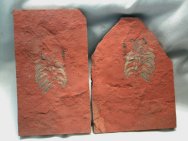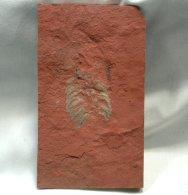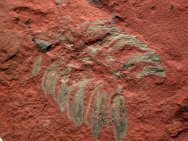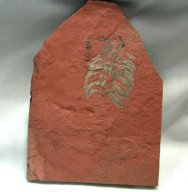| Name:
Burgessochaeta sp.
Phylum Annelida,
Family Burgessochaetidae
Geological
Time: Upper Middle Cambrian
Size (25.4mm=1
inch): 48 mm long by 28 mm wide (maximum) on a 107 mm by 80 mm and 117
mm by 68 mm matrix pair
Location:
House Range, Weeks Formation, Millard County, Utah
Code: UB238
Price: $750.00
- sold
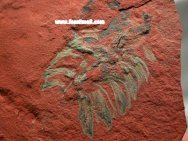 Description:
The Polychaeta (Bristleworms) can trace their ancestry back to the
Cambrian Explosion. The segmented bodies of the Polychaeta have
paired lobes called parapodia which have a function in locomotion
or respiration. The parapodia bear numerous bristles which are the
source of the name of the class (Polychaeta means many bristles).
Modern members of the family Description:
The Polychaeta (Bristleworms) can trace their ancestry back to the
Cambrian Explosion. The segmented bodies of the Polychaeta have
paired lobes called parapodia which have a function in locomotion
or respiration. The parapodia bear numerous bristles which are the
source of the name of the class (Polychaeta means many bristles).
Modern members of the family  prey
upon sponges; perhaps this one did as well . This one is a species
of Burgessochaeta, a taxon known from the Burgess Shale of Canada.
It is not related to any extant bristleworms, and as such has been
assigned its own family: Burgessochaetidae. Intact specimens are
known to possess at least 24 trunk segments, and range in size from
20 mm – 50 mm insize, so this example would have been the
Goliath of all. It is the FIRST and ONLY example I have ever seen
from the Weeks Formation. prey
upon sponges; perhaps this one did as well . This one is a species
of Burgessochaeta, a taxon known from the Burgess Shale of Canada.
It is not related to any extant bristleworms, and as such has been
assigned its own family: Burgessochaetidae. Intact specimens are
known to possess at least 24 trunk segments, and range in size from
20 mm – 50 mm insize, so this example would have been the
Goliath of all. It is the FIRST and ONLY example I have ever seen
from the Weeks Formation.
The
House Range of Utah has several formations that exhibit Burgess
Shale-like preservation of soft tissues, and yield fossils of creatures
closely allied with the Burgess Shale biota. Interestingly, the
formations are normally found in alternating biofacies. Some are
rich in trilobites lacking soft bodied organisms, while adjacent
ones lack trilobites but preserve soft bodied organisms in the form
of kerogenized carbon films. Gaines (2004) has studied the taphonomy
of House Range soft tissue preservation, hypothesizing a taphonomic
pathway much like the Burgess Shale with delayed decay facilitating
rapid diagenesis in an anoxic zone lacking benthic bioturbators.
While soft bodied organisms are far rarer and generally not so exquisitely
preserved as in the Burgess Shale, some scientists believe the House
Range biota might be even more diverse. Many fossils found are enigmatic
as to their taxonomic placement. Unfortunately, the numerous sites
are much understudied, while mining operations are resulting in
wholesale destruction of a potentially rich portion of the Cambrian
fossil record.
References:
- Briggs
D.E.G., and R.A. Robison. 1984. Exceptionally preserved non trilobite
arthropods and Anomalocaris from the Middle Cambrian of Utah.
University of Kansas Paleontological Contributions, Paper 111:1-24.
- Gaines,
Robert R.; Kennedy, Martin J. Droser, Mary L. 2004. A new hypothesis
for organic preservation of Burgess Shale taxa in the middle Cambrian
Wheeler Formation, House Range, Utah. Palaeo, 220:193-205.
- House
Range Fossils: Wheeler Shale, Marjum Formation, and Weeks Formation,
The Virtual Fossil Museum (www.fossilmuseum.net).
|
|


